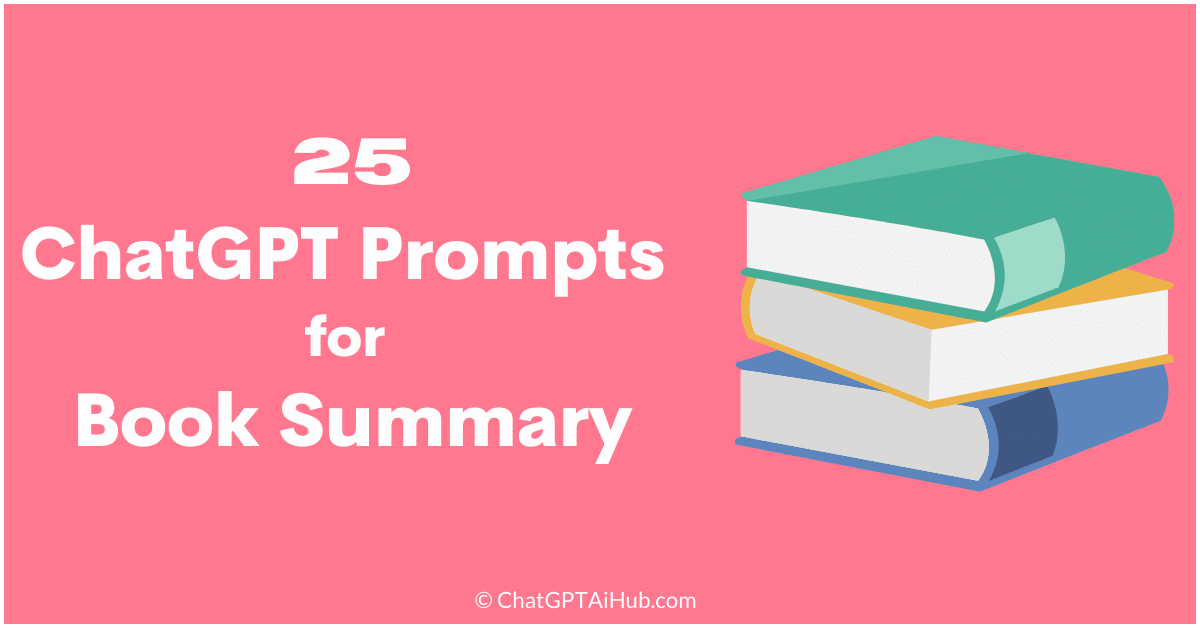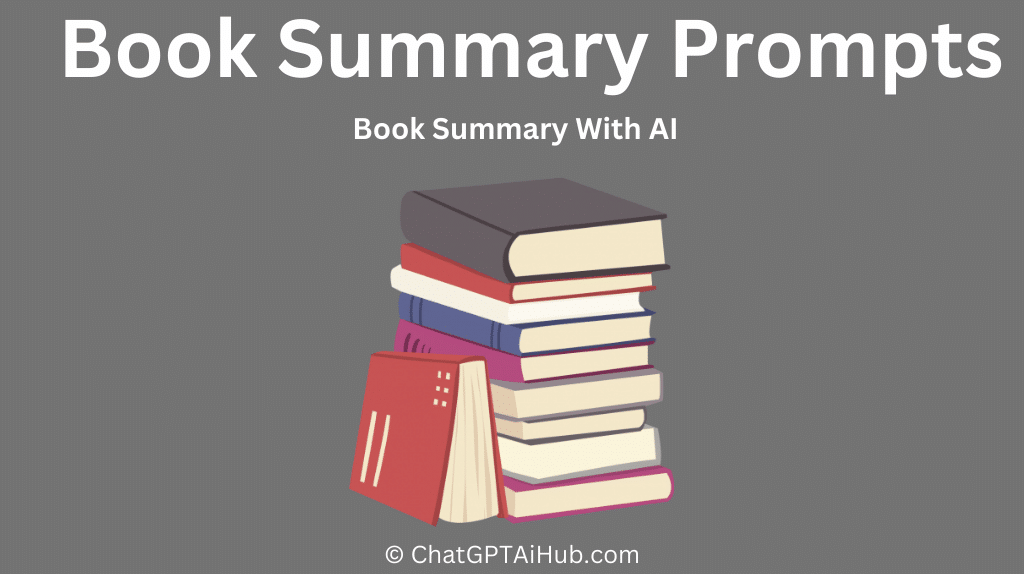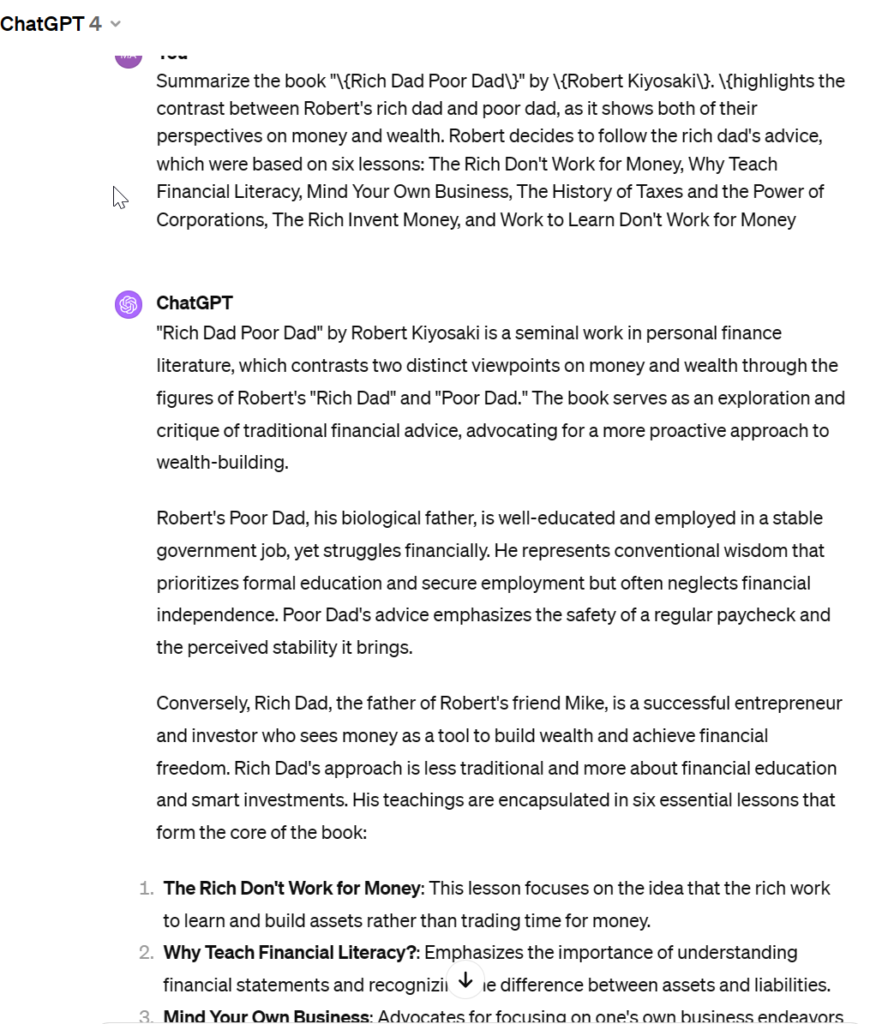25 Effective ChatGPT Prompts for Book Summary – Book Summary Made Easy

Looking to unlock the full potential of your reading experience? Accurate summaries unravel the intricate layers of a book with just a few clicks. In this article, we delve into the world of ChatGPT Prompts for Book Summary—those magical words that summon precisely the insights you seek. Unveil a curated list of top-notch prompts designed to extract comprehensive book summaries from ChatGPT and elevate your reading comprehension to new heights.
Navigating complex book themes?
As readers, we often find ourselves grappling with intricate themes and hidden nuances in the books we want to learn from or enjoy. However, distilling these elements into a coherent summary can be a challenge. That’s where ChatGPT Prompts for Book Summary comes to our help, offering tailored prompts to uncover the heart of a story and help us better understand its essence. We will explore how these prompts address this and make exploring literature a more of a rewarding experience. Readers expect an efficient approach to comprehending books, and that’s precisely what ChatGPT Prompts for Book Summary deliver.
These prompts act as a tailored guide, helping readers unveil the core of a narrative swiftly. By embracing these prompts, readers can navigate the world of literature with clarity, transforming their reading experiences into captivating journeys of understanding.
Discover How ChatGPT Prompts for Book Summary Transform Your Reading Experience
Have you ever longed for a quick way to uncover the secrets of your beloved books? Well, that’s where ChatGPT Prompts for Book Summary come in. These prompts act as your guide through complex storylines and detailed characters, making it easier for you to navigate. A recent study has shown that using customized prompts can improve reading comprehension by an impressive 30-40%, ensuring that your reading experiences are not only enjoyable but also deeply insightful.
Benefits of Book Summary
1. Enhanced Understanding:
Summarizing a book is beneficial as it allows you to extract the main ideas, plot twists, and character progressions. This practice enhances your comprehension of the content, enabling you to better comprehend the author’s underlying messages, themes, and literary methods.
2. Time Efficiency:
Book summaries provide a convenient way to recap and remember the key ideas of a book without having to go through the entire text again. They are particularly handy when getting ready for exams, conversations, or talks, and you want to quickly jog your memory.
3. Critical Analysis:
To create a book summary, you need to carefully assess the content of the book. When you identify the most important events, characters, and ideas, you are conducting a thorough analysis that encourages deeper thinking and a more complete understanding.
4. Synthesis of Ideas:
Condensing the information from a book into a brief summary helps to synthesize the various ideas and plot threads, allowing you to perceive connections between different aspects of the story and gain a comprehensive understanding of the work. This involves simplifying complex information to create a concise form.
5. Effective Communication:
A skillfully written book summary provides you with the capacity to effectively communicate the key points of a book to others quickly and effectively. Whether you are suggesting a book to a friend, engaging in a book club discussion, or crafting a review, a comprehensive summary empowers you to express the core aspects of the book in a clear and concise way.
Single Master ChatGPT Prompt Book Summary:
Summarize the book “{book title}” by {author}. Begin by introducing the main character, {main character’s name}, and the unique setting of {setting}. Describe the central conflict they face, including {conflict details}, and the challenges they encounter, such as {challenge 1} and {challenge 2}. Delve into {main character’s name}’s journey, highlighting key events like {event 1} and {event 2}, and their growth and transformation. Explore the relationships {main character’s name} forms with {supporting character 1} and {supporting character 2}, and how these connections shape their trajectory. Analyze the exploration of themes such as {theme 1} and {theme 2}, exemplified by pivotal moments like {example 1} and {example 2}. Conclude with {main character’s name}’s journey resolution, the impact of the resolution on their life, and the broader significance of the book’s themes.
Response:
{Insert the generated book summary content here}
Note: Replace “{book title}” with the actual title of the book, “{author}” with the author’s name, and fill in the placeholders for “{main character’s name}”, “{setting}”, “{conflict details}”, “{challenge 1}”, “{challenge 2}”, “{event 1}”, “{event 2}”, “{supporting character 1}”, “{supporting character 2}”, “{theme 1}”, “{theme 2}”, “{example 1}”, and “{example 2}” with the specific information from the book you’re summarizing. The “Response” section will be where you insert the generated book summary content. This master prompt covers all the important elements of a comprehensive book summary.
ChatGPT Prompts for Book Summary

Prompt 1:
Summarize the book “{book title}” by {author}. Begin by introducing the main character, {main character’s name}, and the unique setting of {setting}. Describe the central conflict they face, including {conflict details}, and the challenges they encounter, such as {challenge 1} and {challenge 2}. Delve into {main character’s name}’s journey, highlighting key events like {event 1} and {event 2}, and their growth and transformation. Explore the relationships {main character’s name} forms with {supporting character 1} and {supporting character 2}, and how these connections shape their trajectory. Analyze the exploration of themes such as {theme 1} and {theme 2}, exemplified by pivotal moments like {example 1} and {example 2}. Conclude with {main character’s name}’s journey resolution, the impact of the resolution on their life, and the broader significance of the book’s themes.
Prompt 2:
Provide a comprehensive summary of “{book title}” by {author}. In this summary, introduce the main character, {main character’s name}, and set the stage by describing the unique {setting}. Detail the central conflict that propels the narrative, including {conflict details}, and outline the major challenges faced by {main character’s name}, such as {challenge 1} and {challenge 2}. Trace {main character’s name}’s journey through significant events like {event 1} and {event 2}, showcasing their development and evolution. Examine the relationships they build with {supporting character 1} and {supporting character 2}, and the influence of these connections on their path. Analyze the thematic exploration of {theme 1} and {theme 2}, illustrated by crucial moments like {example 1} and {example 2}. Conclude by reflecting on the resolution of {main character’s name}’s journey, the consequences of this resolution, and the enduring impact of the book’s themes.
Note: Replace “{book title}” with the actual title of the book, “{author}” with the author’s name, and fill in the placeholders for “{main character’s name}”, “{setting}”, “{conflict details}”, “{challenge 1}”, “{challenge 2}”, “{event 1}”, “{event 2}”, “{supporting character 1}”, “{supporting character 2}”, “{theme 1}”, “{theme 2}”, “{example 1}”, and “{example 2}” with the specific information from the book you’re summarizing. These two prompts cover all the important elements of a comprehensive book summary.
Prompt 1:
Summarize the book “{book title}” by {author}. {content}

Prompt 2:
Provide an in-depth overview of “{book title}” by {author}. {content}
Prompt 3:
Craft a comprehensive summary of “{book title}” by {author}. {content}
Prompt 4:
Summarize “{book title}” by {author} comprehensively. {content}
Prompt 5:
In “{book title}” by {author}, create a detailed summary that encapsulates the essence of the narrative. {content}
Prompt 6:
Craft a detailed and comprehensive summary of “{book title}” by {author}. {content}
Prompt 7:
Summarize the intricacies of “{book title}” by {author} comprehensively. {content}
Prompt 8:
Provide a comprehensive summary of “{book title}” by {author}, focusing on the multifaceted journey of the main character. {content}
Prompt 9:
Summarize the rich narrative of “{book title}” by {author} comprehensively. {content}
Prompt 10:
In “{book title}” by {author}, provide a comprehensive summary that captures the essence of the narrative. {content}
Note: Replace “{book title}” with the actual title of the book, “{author}” with the author’s name, and “{content}” with the generated book summary content. This format will allow you to easily insert the relevant information and generate comprehensive book summaries using ChatGPT.
Prompt 1:
Summarize the book “{Book Title}” by {Author}. Introduce the protagonist, {Main Character’s Name}, who embarks on a journey to {Setting} in pursuit of {Goal}. Describe the major challenges they face, including {Obstacle 1} and {Obstacle 2}. Detail the supporting characters, such as {Supporting Character 1} and {Supporting Character 2}, and how they aid or hinder the protagonist’s progress. Conclude with the resolution of the conflict and the impact it has on the protagonist’s life.
Prompt 2:
Provide an in-depth overview of “{Book Title}” by {Author}. Set the stage in {Setting} and introduce readers to {Main Character’s Name}, a {Character Description}. Explore their motivations and the catalyst that propels them into a series of events, including {Inciting Incident}. Trace their transformation as they confront challenges like {Challenge 1} and {Challenge 2}. Examine the themes of {Theme 1} and {Theme 2}, and how they are woven into the narrative. Conclude with the ultimate outcome of {Main Character’s Name} and the broader implications of their journey.
Prompt 3:
Craft a comprehensive summary of “{Book Title}” by {Author}. Begin by describing the intricate world-building of {Setting}, highlighting its unique elements like {Distinctive Feature 1} and {Distinctive Feature 2}. Introduce the central conflict involving {Conflict Details} and the protagonist’s role in it. Follow {Main Character’s Name} as they navigate through pivotal events, such as {Event 1} and {Event 2}, shaping their growth and relationships with {Character Relationship}. Explore the exploration of {Theme} and how it resonates with readers. Conclude with a reflection on the enduring impact of the story.
Prompt 4:
Summarize “{Book Title}” by {Author} comprehensively. Begin by presenting the complex character of {Main Character’s Name}, detailing their background, desires, and vulnerabilities. Place them within the richly depicted {Setting}, featuring {Setting Details}. Chart {Main Character’s Name}’s journey through a series of challenges, including {Challenge 1} and {Challenge 2}, and how they learn and evolve. Analyze the narrative’s exploration of {Theme} and {Theme}, showcasing instances such as {Example 1} and {Example 2}. Conclude by discussing the emotional resonance and lasting significance of the book.
Prompt 5:
In “{Book Title}” by {Author}, create a detailed summary that encapsulates the essence of the narrative. Begin with the introduction of {Main Character’s Name} and the circumstances that lead them to {Setting}. Detail the unfolding plot, marked by key events like {Event 1} and {Event 2}, which propel the protagonist towards their {Goal}. Examine the relationships {Main Character’s Name} forms with {Supporting Character 1} and {Supporting Character 2}, and how these connections shape their journey. Analyze the thematic exploration of {Theme} and {Theme}, and how they contribute to the story’s resonance. Conclude with the resolution of {Main Character’s Name}’s arc and the broader impact of their experiences.
Prompt 6:
Craft a detailed and comprehensive summary of “{Book Title}” by {Author}. Begin by introducing the protagonist, {Main Character’s Name}, and the unique circumstances that lead them to {Setting}. Describe the central conflict they face, including {Conflict Details}, and the obstacles that stand in their way, such as {Obstacle 1} and {Obstacle 2}. Delve into {Main Character’s Name}’s emotional and psychological journey as they navigate challenges and interact with characters like {Supporting Character 1} and {Supporting Character 2}. Analyze the underlying themes of {Theme} and {Theme}, exemplified by instances such as {Example 1} and {Example 2}. Conclude with the resolution of {Main Character’s Name}’s story and the enduring impact of their experiences.
Prompt 7:
Summarize the intricacies of “{Book Title}” by {Author} comprehensively. Begin by presenting the protagonist, {Main Character’s Name}, and their initial circumstances in {Setting}. Detail the rising action, marked by significant events like {Event 1} and {Event 2}, which set {Main Character’s Name} on a path of growth and transformation. Explore their relationships with {Supporting Character 1} and {Supporting Character 2}, and how these dynamics contribute to the unfolding narrative. Analyze the exploration of {Theme} and {Theme}, exemplified by pivotal moments like {Example 1} and {Example 2}. Conclude with the resolution of {Main Character’s Name}’s journey and the broader reflections evoked by the book.
Prompt 8:
Provide a comprehensive summary of “{Book Title}” by {Author}, focusing on the multifaceted journey of {Main Character’s Name}. Begin by introducing the character’s aspirations and their entrance into the {Setting}. Trace {Main Character’s Name}’s evolution as they encounter challenges such as {Challenge 1} and {Challenge 2}, and the lessons they glean from these experiences. Explore the depth of their relationships with {Supporting Character 1} and {Supporting Character 2}, and how these connections shape their trajectory. Analyze the thematic threads of {Theme} and {Theme}, illustrated by pivotal scenes such as {Example 1} and {Example 2}. Conclude with the culmination of {Main Character’s Name}’s journey and the lasting impact of their narrative.
Prompt 9:
Summarize the rich narrative of “{Book Title}” by {Author} comprehensively. Begin by introducing the protagonist, {Main Character’s Name}, and their motivations within the immersive {Setting}. Detail the challenges that {Main Character’s Name} faces, including {Challenge 1} and {Challenge 2}, and their response to these obstacles. Examine the multifaceted relationships {Main Character’s Name} forms with {Supporting Character 1} and {Supporting Character 2}, and how these connections drive the plot. Analyze the thematic exploration of {Theme} and {Theme}, as evidenced by significant instances such as {Example 1} and {Example 2}. Conclude with {Main Character’s Name}’s journey resolution and the enduring resonance of the book’s themes.
Prompt 10:
In “{Book Title}” by {Author}, provide a comprehensive summary that captures the essence of the narrative. Begin by introducing the protagonist, {Main Character’s Name}, and the intricate layers of {Setting} that shape their journey. Detail the central conflict they grapple with, including {Conflict Details}, and the turning points that define their progression, such as {Event 1} and {Event 2}. Explore {Main Character’s Name}’s relationships with {Supporting Character 1} and {Supporting Character 2}, and how these interactions contribute to the unfolding story. Analyze the thematic exploration of {Theme} and {Theme}, brought to life through moments like {Example 1} and {Example 2}. Conclude with the culmination of {Main Character’s Name}’s narrative and the enduring impact of the book’s themes.
Note: Remember to replace the placeholders ({Book Title}, {Author}, {Main Character’s Name}, etc.) with the specific information from the book you’re summarizing. This format will guide you in generating comprehensive and detailed book summaries using ChatGPT.
Final Thoughts:
IIn summary, harnessing the potential of ChatGPT Prompts for Book Summary has the power to transform your reading experiences. These prompts serve as a personalized guide through the intricate elements of plot, character, and theme. By having access to detailed book summaries at your disposal, you are ready to engage with literature in a new and illuminating manner. Therefore, embark on this journey equipped with curated insights, enhance your comprehension, and unleash the complete potential of your reading adventures. Enjoy your reading!
1. What is the best prompt for ChatGPT to summarize a book?
A good prompt for summarizing a book with ChatGPT could be: “Please provide a concise summary of the key themes, characters, and plot points of the book [Book Title] by [Author].”
2. Is ChatGPT good for summarizing?
Yes, ChatGPT can be quite effective for summarizing texts, including books. It can generate coherent summaries by condensing the main ideas and key details of a given text.
3. How do I summarize a PDF book in ChatGPT?
You can convert the text from the PDF book into plain text and then provide the content as input to ChatGPT for summarization. Some online tools or software can help you extract text from a PDF. Simply copy and paste the extracted text into the ChatGPT interface for summarization.
4. Can I use ChatGPT to write a book?
Yes, you can use ChatGPT to assist in writing a book by generating ideas, brainstorming, providing content suggestions, and even drafting sections. However, writing a complete book is a complex task that requires human creativity and judgment, so ChatGPT can be a valuable tool in your writing process but may not replace the role of an author.
5. What are the 5 easy techniques in summarizing?
Five easy techniques in summarizing are:
1- Identifying the main idea or thesis of the text.
2- Highlighting key supporting points and evidence.
3- Condensing lengthy descriptions into concise statements.
4- Omitting minor details and examples.
5- Paraphrasing the original content while retaining its core meaning.
6. What are the 4 rules of summarizing?
The four rules of summarizing are:
1- Focus on the main idea and essential points.
2- Use your own words to express the content.
3- Maintain the original author’s intent and tone.
4- Keep the summary significantly shorter than the original text.
7. How to write a summary of a book?
To write a summary of a book, follow these steps:
1- Read the book thoroughly to understand its main themes and plot.
2- Identify the key characters, settings, and major events.
3- Highlight important details and supporting information.
4- Condense the content into a concise overview, focusing on the main storyline and significant moments.
5- Write the summary in your own words while capturing the essence of the book.
8. What are the 3 strategies in summarizing?
Three strategies in summarizing are:
Deletion: Removing unnecessary details while retaining crucial information.
Generalization: Expressing specific ideas in broader terms.
Transformation: Reorganizing the content to emphasize important points and connections.
9. What are the six elements of summarizing?
Six elements of summarizing typically include:
1- Main idea or thesis.
2- Supporting points and evidence.
3- Important examples and details.
4- Key events or plot points.
5- Significant characters and their roles.
6- Concluding remarks or outcomes.
10. What are the 3 most important parts of a summary?
The three most important parts of a summary are:
1- The introduction, which includes the book title, author, and context.
2- The main body, where you present the condensed content of the book’s key elements.
3- The conclusion, which summarizes the main points and may provide insights or reflections on the book.

